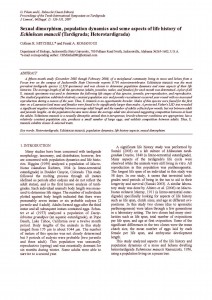G. Pilato and L. Rebecchi (Guest Editors)
Proceedings of the Tenth International Symposium on Tardigrada
J. Limnol., 66(Suppl. 1): 126-131, 2007
ABSTRACT
A fifteen month study (December 2002 though February 2004) of a meiofaunal community living in moss and lichen from a
Pecan tree on the campus of Jacksonville State University reports 9,791 microinvertebrates. Echiniscus mauccii was the most
prevalent tardigrade species (1,329 specimens) and was chosen to determine population dynamics and some aspects of their life
histories. The average length of all the specimens (adults, juveniles, males, and females) for each month was determined. A plot of all
E. mauccii specimens was used to determine the following life stages of this species; juvenile, pre-reproductive, and reproductive.
The studied population exhibited relatively constant population size and juvenile recruitment occurred year round with no increased
reproduction during a season of the year. Thus, E. mauccii is an opportunistic breeder. Males of this species were found for the first
time on a Laurasian land mass and females were found to be significantly larger than males. A protected Fisher’s LSD test revealed
a significant negative relationship between average adult length and the number of adults collected per month, but not between adult
and juvenile lengths. As the population became more dense the average adult size decreased suggesting competition between at least
the adults. Echiniscus mauccii is a sexually dimorphic animal that is iteroparous, breeds whenever conditions are appropriate, has a
relatively constant population size, produces a small number of large eggs, and exhibits competition between adults. Thus, E.
mauccii exhibits classic K-selected traits.
Key words: Heterotardigrade, Echiniscus mauccii, population dynamics, life history aspects, sexual dimorphism
We have many publications that help us relay tardigrade facts to you this is one of those articles.
~Ella



